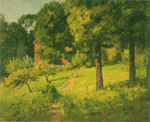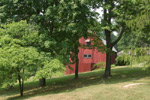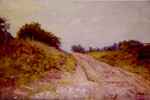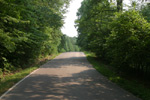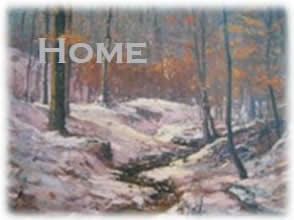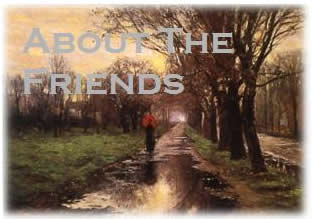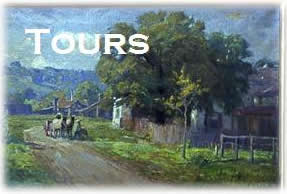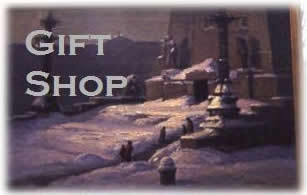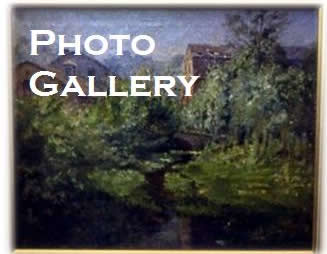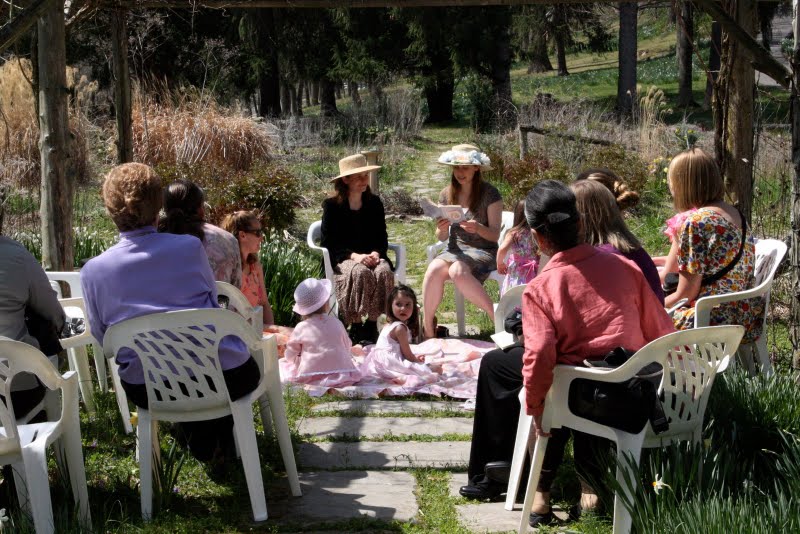Tours

Guided tours of historic site buildings are available.
Hours: Tuesday-Saturday, 9 a.m. - 5 p.m.; Sunday, 1-5 p.m.
We are closed on Mondays
Now Open Year Round
Including These Major Holidays
Memorial Day, Fourth of July, Labor Day
Building tour program fee
Standard admission: $3.50 for adults, $3 for seniors 65 and older,
$2 for children 12 and under.
Group tour: $3 for adults $1.50 for children
School groups on field trips: $1/person
Exploring the grounds including trails, gardens, and nature preserve are FREE of charge.
Special discounts:
--Friends of T.C. Steele members receive a tour of the facilities free of charge and a 10% museum shop discount. Friends members also receive a discount on programs which is as follows:
$1 off programs $5 and under
$2 off programs $5-$10
$3 off programs over $10
--We honor AAA membership and National Trust for Historic Preservation member discounts, which reduces the tour price by $.50 and you would receive a 10% discount in the museum gift shop.
Get the brochure here!
<% End If If strSelectedSection = "pergola" Then %>
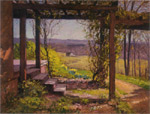
Pergola in Early Spring, 1918 Oil on canvas; T.C. Steele SHS
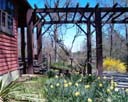
A photograph of the Pergola, taken in the Spring of 2005 |
Location 2 "Pergola in Early Spring"
According to one art critic for the Indianapolis Star, Steele's landscapes were of "nature in repose rather than nature in action...there is always a feeling of freedom, as one looks out, across or up vistas and wide valleys and distant hills and the blue sky above..." The 19th-century farmers who cleared the Brown County hillsides created the perfect subject matter for an artist of Steele's preferences. When Steele arrived in 1907 there was a 20-mile view to the north as seen through the arbor, or pergola.
Steele preferred the dramatic lighting of the early morning and late afternoon, often rising as early as 4:00 a.m. to paint. In Pergola in Early Spring, he studied the patterns of light shining through the foliage, a common subject of Impressionist painters. Steele would often place the foreground in shadow, with bright patches of light in the mid- and background to guide the eye into the composition. Here, the vivid yellow of daffodils adds to the effect. |
<% End If If strSelectedSection = "Slope" Then %>
Location 3 "North Slope Vista"
During his days in Munich, Steele developed a preference for landscapes that had a particular internal logic. In his landscape sketches and paintings, Steele returned again and again to compositions in which the eye is led into distance by means of water, a road, or a border of trees. Here, the eye is drawn by the road and the strong diagonal of the trees to a distant view of the nearby Washington Parks homestead. In 1910 the Steeles purchased this 40- acre farm, acquiring additional vistas to the north and west.
In his pre-Munich days, Steele dabbled in photography. This relatively new technology, along with the mid-19th-century introduction of Japanese art to the west, had a profound effect on Impressionist landscape compositions. The asymmetrical arrangement of landscape features in this painting is typical of Japanese prints. The strongly vertical foreground trees help “ground” the composition. In his later years, Steele occasionally returned to the camera to supplement his preliminary sketches. |
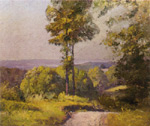
North Slope Vista, 1924 Oil on canvas; T.C. Steele SHS
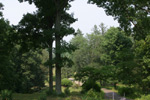
A photograph of the North Slope Vista, taken in 2002 |
<% End If If strSelectedSection = "oak" Then %>
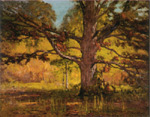
Old Oak Tree, 1917 Oil on canvas; T.C. Steele SHS
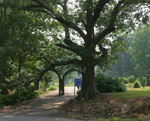
A photograph of the Old Oak Tree, taken in 2002 |
Location 4 "Old Oak Tree"
Steele varied his panoramic vistas with landscapes which provided a more intimate view of nature. The Old Oak Tree is, in essence, a portrait of a tree: individual and distinctive in its features. One of the few truly old trees on the property when Steele purchased it, this scarred veteran has survived with a few changes-limbs have been lost to time, weather, and tall vehicles- but it is still recognizable as the venerable oak depicted by Steele.
|
<% End If If strSelectedSection = "gate" Then %>
<% End If If strSelectedSection = "wash" Then %>
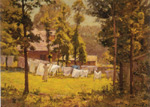
Week's Wash, 1910 Oil on canvas; T.C. Steele SHS
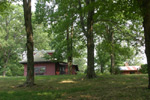
A photograph of the Week's Wash, taken in 2002 |
Location 6 "Week's Wash"
In his later years, Steele increasingly turned to "pure" landscapes, in which no people or animals appear. He may have felt this would allow the technical elements to stand out more strongly, elements, which he termed the "quality of a picture’s tone, the music of its color." The artist made frequent exception, however, for his wife. He featured Selma many times in his landscapes as she engaged in domestic activities or worked in the garden. Selma took great pride in any contribution she was able to make to her beloved husband's work.
The building in the background is not the Large Studio; rather it is the older Little Studio. This building, which now serves as the site office, was moved to its present location in the early 1920s after standing for many years on the west side of the driveway. After construction of the Large Studio between the Little Studio and this location, the Little Studio was obscured from view by the larger building. |
<% End If If strSelectedSection = "porch" Then %>
Location 7 "West Porch in Winter"
In the nineteen years T.C. and Selma Steele shared the House of the Singing Winds, it was never truly completed. The core section was built in 1907, the house nearly doubled in size the following year, and additions and changes continued to be built in the ensuing years. Ten days before his death, as workmen bustled around him making yet another alteration to his home, Steele wrote, "It is good to hear hammer and saw. It means someone is well and at work." Steele's paintings of his home, studios and other structures help guide building restoration.
The House of the Singing Winds was, at first, strictly a seasonal home. Steele first modified his habit of spending winters in Indianapolis in 1910, when he constructed two tiny studios on the property and spent the winter landscape painting. Gradually, the home became more of a year-round residence. When Steele became formally associated with Indiana University in Bloomington, he was better able to paint the site year-round.
Visitors are invited to tour the historic Large Studio and House of the Singing Winds during the site's regular hours of operation. To see more paintings by T.C. Steele, visit nearby Indiana University where Steele served as Indiana University's first Artist in Residence from 1922 until his death in 1926. |
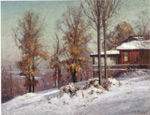
West Porch in Winter, 1922 Oil on canvas; T.C. Steele SHS
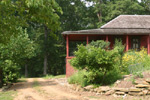
A photograph of the West Porch in Winter, taken in 2002 |

